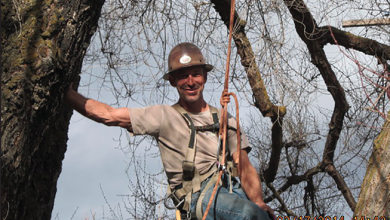Ground Cover and Trees…
Many urban trees around town that I care for exist in a “sea” of ground cover. On a hillside environment, the common cure for erosion is a mass planting of English ivy, St. John’s wort, or Vinca major. The downside to these types of ground cover is numerous.
When I give a tree the “once over”, the first place I need to examine is the root collar or buttress. Dense ground cover growing up to the stem of the tree hides the collar, making examination impossible without tearing it out to make an evaluation.
While not allelopathic per se, these plantings harbor fungus, that while beneficial to their own root systems through a micorrhizal relationship in the soil, are a detriment to the fungus that the tree needs to survive. The problem is displacement, pure and simple. There just isn’t any room left in the soil strata for the good stuff your tree needs! If the ground cover looks lush and happy, that means the fungus for that plant is active, vibrant, and exclusionary. In short, if the ground cover looks great, the tree is suffering!
With conifers such as Pines, Cedars, true and Doug firs, the detriment isn’t as severe as with say, native oaks, but all trees do not enjoy ground cover invading their root zones to say the least!
The next problem with dense ground cover is water not infiltrating the soil and making it to the roots of the tree as the plants get first dibs, especially in summer.
Getting rid of established mature English ivy is not an easy task, I usually farm the job out to a licensed landscape contractor. The best way to eliminate ground cover is to grub it ALL out, roots and all. Depending on soil types this can be a task of herculean effort! Another method is to beat it down as far as possible with a mower or weedeater and sheet mulch with cardboard and chips on top to deny it sunlight long enough to make it give up the ghost! This may take a couple of years, but done correctly, it works. I won’t poison ANYTHING ever, I just don’t think dumping anymore chemicals on Mother Earth is a good idea, but it is a remedy if done right…
Everyone asks, “How far back should I take the ivy from my tree?”
“England would be a good start,” is my answer, and I’m not kidding…
Once you have the offending material out, you may have to be creative in keeping erosion to a minimum, such as gentle terracing, installation of low growing shrubs, or “creepers” such as manzanitas, or the like, and boulder placements. Do some research, and avoid plants that are prone to fireblight such as cotoneaster, pyracantha, etc.
Looking for expert tree doctors in Clovis?
Of all the invasive plants I can think of, dense ground cover run wild has to be the worst! In small strips, borders and such, it can be managed, but when it breaks out of its cage, it takes off willy-nilly and smothers everything in its path!
There are some creek side properties that are essentially ruined until it all comes out, and that will take some serious doing. Fall planting time is here, and is also a great time to break out the gloves, mattock, and weed eater and give that ground cover a tune up!



